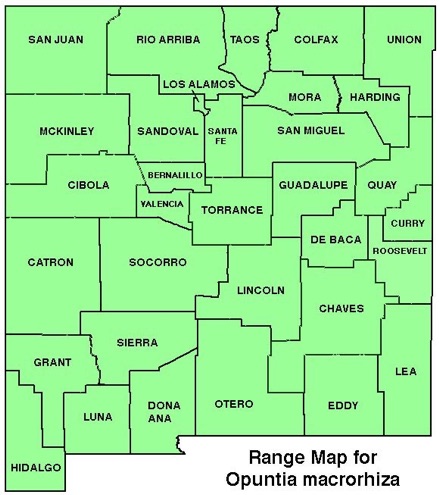WILDFLOWERS OF NEW MEXICO

This sprawling 6–12-inch tall prickly pear has round to oblong jointed pads, 3–5 1/8-inches long (7.5–13 cm) and 3–4 3/4-inches (8–12 cm) wide, that appear wrinkled after first winter. Clumps usually spread along the ground in chains 1–2 pads high and root. The roots form tuber-like swellings up to 1-inch thick, and the yellow flower petals usually have red bases.
SPINES: Pads lined with diagonal rows of 5–7 areoles at midstem with tufts of tiny hair-like bristles (glochids). Areoles usually have 1–3 white to reddish-brown spines, mainly on upper portion and edges of the pad; spines can reach 2 1/2-inches long (6 cm), straight or curved, lowermost pointing downward. The plant’s spines are treacherous, but beware the barbed, hair-like glochids which can cause considerable pain.
FLOWER: May–June. Bright yellow, 2–3-inch wide (5–8 cm) flowers, usually with red basal markings, filaments pale yellow, stigmas with creamy to yellow-greenish lobes. Fruits fleshy, dull-red, elongated, 1–1 1/2-inches long (25–38 mm), areoles with a glochid bristles but no spines.
HABITAT: Loose sand, gravelly soils; desert grasslands and scrub, pinyon-juniper woodlands.
ELEVATION: 3,400–8,000 feet.
RANGE: Widespread west of the Mississippi River.
SIMILAR SPECIES: Pott’s Prickly Pear, O. pottsii (O. michrohiza var. pottsii), in cen. and so. NM, typically doesn’t form long chains of rooting pads, and has reddish flowers–though no unique set of features separate it from O. macrorhiza. Twist-spine Prickly Pear, O. tortispina (O. microrhiza var. microrhiza), in the eastern half of NM, has 4–5 central spines/areole, and spines on all or upper 3/4 of pad. These three species are often confused in the field and literature.
NM COUNTIES: Statewide in low- to mid-elevation, dry habitats.









PLAINS PRICKLY PEAR CACTUS
OPUNTIA MACRORHIZA
Cactus Family, Cactaceae
Perennial cactus









THE CONTENTS OF THIS WEBSITE ARE COPYRIGHTED AND CANNOT BE USED
WITHOUT PERMISSION OF GEORGE OXFORD MILLER






































































EMAIL ME







